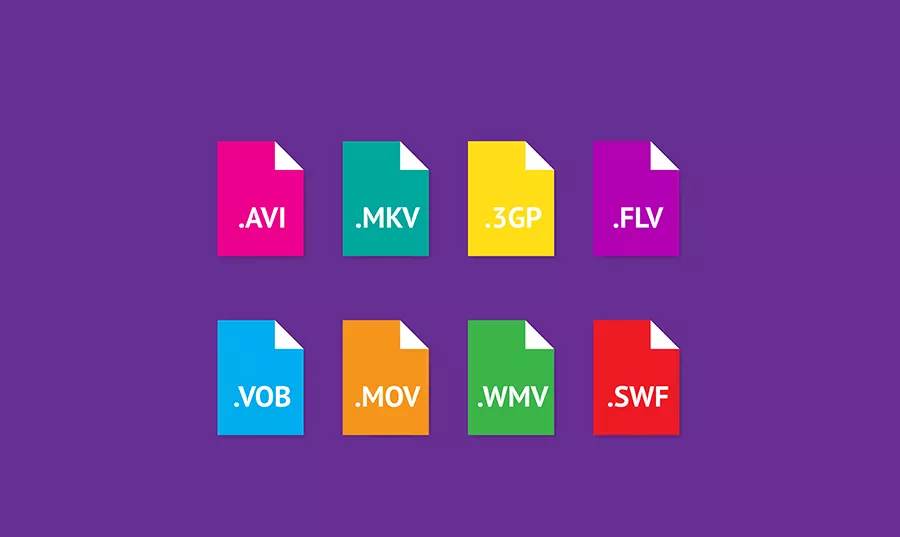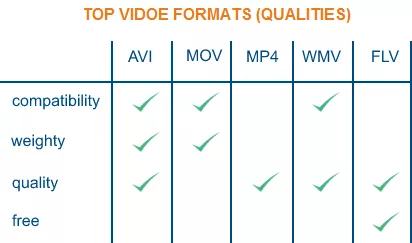Understanding Different Video Formats & Comparing Their Benefits
With the growing demand for online video content, understanding the different video formats and their benefits is becoming increasingly important. Different video formats have their own unique strengths and weaknesses, and it is important to know which format is best suited for a particular use case.
In this article, we will take a look at some of the most common video formats and compare their benefits to help you make an informed decision when selecting a video format for your project.
Explaining video formats Codec & Container
Container and codec are two terms that need to be defined before we can move on to discussing the various video formats. For a video format, a difference is always established between the container and the codec.
Container
In theory, a container is simply a type of wrapper for digital audio and video tracks. It includes information about the video itself, such as the resolution or frame rate, as well as information about the audio track, language, or bit rate at which the video is made available.
Codec
The true beating heart of a video is the codec. Depending on the codec, it compresses and decompresses (encodes and decodes) the video to varied degrees of quality. Lossy and lossless codecs are the two categories.
The quality of the original is completely maintained while using lossless codecs, which compress the video without losing any features. However, lossless codecs often require a lot of resources, which makes the movie quite big.
The Future of Video Quality & Storage Space – 4K & 8K Resolutions
The future of video quality and storage space is being revolutionized by the introduction of 4K and 8K resolutions. With 4K resolution providing four times the number of pixels compared to 1080p, and 8K resolution offering sixteen times more pixels than 1080p, these resolutions are sure to bring about a new era in the world of digital media.
Furthermore, 4K and 8K resolutions will have a major impact on long-term storage solutions as they require significantly more memory space than their predecessors.
What is 4K resolution?
4K refers to a horizontal pixel count of 3840 pixels (or 4000 for its non-horizontal variants) and a vertical pixel count of 2160 pixels. This means that 4K video files are four times the size of 1080p video files.
There is no fixed format for 4K content, unlike 1080p which uses the progressive scan format, meaning that 4K content should be preferred over 1080p as it can have better detail and smoother images. The increase in size may also make it harder to share these videos with friends or family members who don’t have 4 K capable devices.
The files are susceptible to degradation from noise and compression artifacts, which can be a problem if these effects are present in the original video. 4K is a resolution of 3840×2160, which equates to approximately 8.3 million pixels per frame. In comparison, 1080p has a resolution of 1920×1080 or 2 million pixels per frame.
What is important?
Choosing the right video format is essential for achieving the best temporal and visual quality. With the increasing demand for high-resolution videos, it is important to understand which video format will give you the highest quality.
What is a Video Format?
The term “video format” is used to describe the specific type of video that you are shooting. For example, if you are recording a movie with a DV camera, you would be using video format DV. There are many different video formats that exist today, and they vary in quality due to size and compression.
Common Video Formats

Different video formats offer different advantages and disadvantages, depending on the type of content you are creating. When it comes to video file formats, MKV and MP4 are two popular video formats.
MKV Video File Format
If you want to take advantage of a variety of different codecs in a single file without having to encode videos from scratch every time, then MKV is the format for you. MKV files consist of multiple different video tracks that are encoded in different codecs. This allows a single file to be compatible with just about any device you throw at it.
MPEG-2 Video
If you want to take advantage of a variety of different codecs in a single file without having to encode videos separately, then this is one of the best options.
QuicktimePros
Quicktime is an open-source video format that can be read, written, and played by a variety of different applications. This makes it easy to use the same file in multiple editing software packages. Another advantage of Quicktime is that it is widely available on most operating systems.
In addition, Apple’s Pro Res specification supports a wide range of resolutions and frame rates for Quicktime files, making them perfect for editing media for broadcast or streaming content online.
MPEG-1
Videos on cassette and compact discs (CDs) often adhere to this standard. Compared to other MPEG standards, the video quality and frame rate are both subpar.
AVI
This format is quite widespread, thus it can be read by a wide variety of gadgets and software. The files in the AVI format are often rather big because of the inefficient compression method used.
WebM
It’s a standard file type, but not every player or app is compatible with it. Created by Microsoft.
MPEG-4
Compression generally results in poor visual and sound quality, making it best suited for online use. Created by Adobe.
3GP
Its low data consumption is a key feature given that it was designed for mobile devices. Created by Adobe.
HTML5 / WebM
WebM was created by Google and is a free and open standard for video sharing online. It’s a Matroska-derived format designed to work with the HTML5 web standard. It provides high-quality compression while still being playable in all major browsers.
Which video format is superior?
The optimal video format is circumstance-specific. Making a web video requires a format that is supported by the most widely used browsers. Other formats are more suited for use while making a video on a DVD.
Video files saved in MPEG format are usually the best option because of their high compression ratio and wide compatibility.
For websites, it is crucial that the format be supported by every browser, hence MPEG-4 is a solid choice. WebM’s tiny file size and quick loading times make it an ideal format for embedding on websites. Older browsers will not be able to show it.
Which video format provides the highest quality?

MOV is a container for high-quality video, audio, and effects data. The problem is that these files tend to be somewhat big. Similar to the MOV format, the WMV format can store a lot of video without sacrificing quality. However, the quality is affected not just by the format but also by the amount of compression applied and the rendering quality chosen.
What is the most internet-friendly video format?
WebM is the optimal format for streaming media online. It was built from the ground up to work with the HTML5 standard for websites. WebM is supported by all major browsers and provides high-quality compression while still being playable.
What is YouTube’s best video format?

YouTube claims that MP4 is the ideal video format for full HD videos (1920 x 1080 pixels). YouTube goes on to list more excellent practices, such as:
- H.264 codec
- 15-20 Mbps
- AAC-LC audio codec
When it comes to playing videos on different gadgets, what format is the most popular?
The most used video file type is MPEG-4, which is also known as H.264 or AVC. Even while Apple favors this format, it is compatible with most other devices. Despite its lesser quality compared to other formats, MP4 is ideal for sharing videos on social media platforms like YouTube, Facebook, Twitter, and Instagram.
Conclusion
Since they can typically be recognized by one another for the problems they resolve, there hasn’t been a single video format that has emerged as the industry norm. And even while customers will undoubtedly want ever-higher standards as technology advances, many of the most common video formats will continue to be extremely important for years to come.









